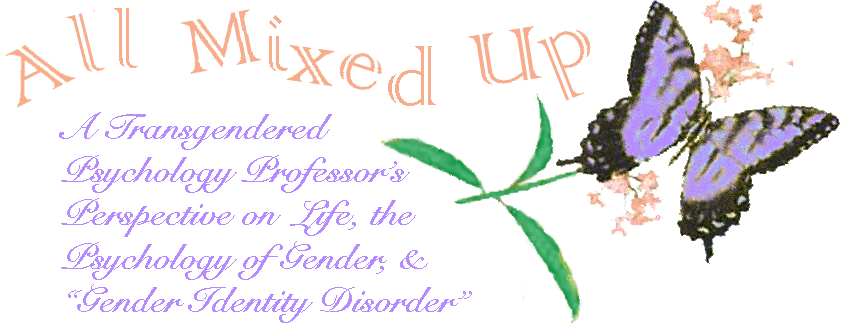
|
|

|
Autogynephilia is the key concept in a theoretical account of transsexualism and crossdressing most strongly advocated by Ray Blanchard, J. Michael Bailey, and Anne Lawrence. Among transsexuals AGP and BBL are common abbreviations for autogynephilia and Blanchard-Bailey-Lawrence theory. Here are psychological accounts by Ray Blanchard and me (Madeline Wyndzen). I include my responses to the way Alice Dreger, J. Michael Bailey and Anne Lawrence frame the discussion of transgenderism. Finally, I provide links to diverse sides in this all-too-contentious debate.
I first read Ray Blanchard's research-oriented papers on autogynephilia years ago, before his ideas became well known in the transgendered community. Reading his work directly rather than filtered through another's perspective had a profound impact on the way I view the theory. To me, it was neither the revelation and inspiration it was to Anne Lawrence (Men Trapped in Men's Bodies': An Introduction to the Concept of Autogynephilia) nor something to revile as many transsexuals see in its portrayal by J Michael Bailey (The Man Who Would Be Queen: The Science of Gender Bending and Transsexualism).
For many years there has been tension between transsexuals who would like to define themselves and the mental health community who felt they had this responsibility. Blanchard's theory has become a flash-point. As both of transsexual and a psychologist, I tried to handle the situation with the utmost care and sensitivity. Then J. Michael Bailey endorsed Blanchard's model in his new book and gave a forceful refusal to be a "slave to sensitivity."
Now it's practically impossible for transsexuality to be discussed or understood without Blanchard's model as a bench-mark. The level of hostility and mis-attribution from all sides shocks me. My hope with this collection of essays is to bring both a scientific psychological perspective and a personal transsexual perspective together to understand what autogynephilia really means. I hope to show that, to the extent Blanchard's model shows promise, it only recongizes the the richness of transgender sexual experiences. Other interpretations come out of less than scientifcally rigorous thinking: value judgements, unwarranted assumptions arising from methodological flaws, and the over-interpretation of data. I hope to show where each side is coming from and why neither means to be as hostile as we appear to each other. I hope, someday, we can work together to give both transsexuals and psychologists dignity in how we define ourselves and how we understand each other.
|
|
|